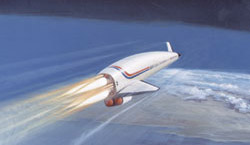HOTOL (Horizontal Takeoff and Landing vehicle)

HOTOL (Horizontal Takeoff and Landing vehicle) is a British design, conceived by Alan Bond, for a single-stage-to-orbit winged launch vehicle using a unique air-breathing engine design. The RB545 air/liquid hydrogen/liquid oxygen (LOX) engine was to be developed by Rolls-Royce. Work on HOTOL began in 1982 by a Rolls-Royce/British Aerospace team and had reached the stage of detailed engine design and mock-up when, in the mid-1980s, the British government withdrew further funding.
HOTOL would have taken off horizontally with a rocket-propelled trolley, switched to pure rocket propulsion at Mach 5–6, ascended to orbit, and glided back to Earth like the Space Shuttle to a runway landing. The HOTOL airframe was derived from conventional vertical takeoff rockets with the engines mounted at the rear of a blunt based fuselage. Since such a vehicle's empty center of gravity is dominated by the location of the engine, the wings and the tank for the dense LOX also had to be at the rear. The payload bay and hydrogen tankage were placed in a projecting forebody. The resulting configuration suffered from a severe center of pressure/center of gravity mismatch during the air breathing ascent. The center of pressure shifted 10 m forward, due to the wide Mach range, the large fuselage cross-section to wing area ratio, and the long overhang of the forward fuselage. Various design changes were made to address these problems, all of which eroded the payload. Conventional landing gear was replaced by a specially designed takeoff trolley to improve the marginal payload fraction. The final design had serious operational disadvantages and a small payload, and the only way the designers could continue to claim to put a reasonable payload into orbit was by specifying untried and speculative structural materials. HOTOL subsequently evolved into Skylon which is being developed by Bond and his colleagues at Reaction Engines Ltd.
| length | 75.0 m |
| core diameter | 7.0 m |
| liftoff thrust (from 3 engines) | 3,153,200 N |
| mass | 250,000 kg (total), 50,000 kg (empty) |


